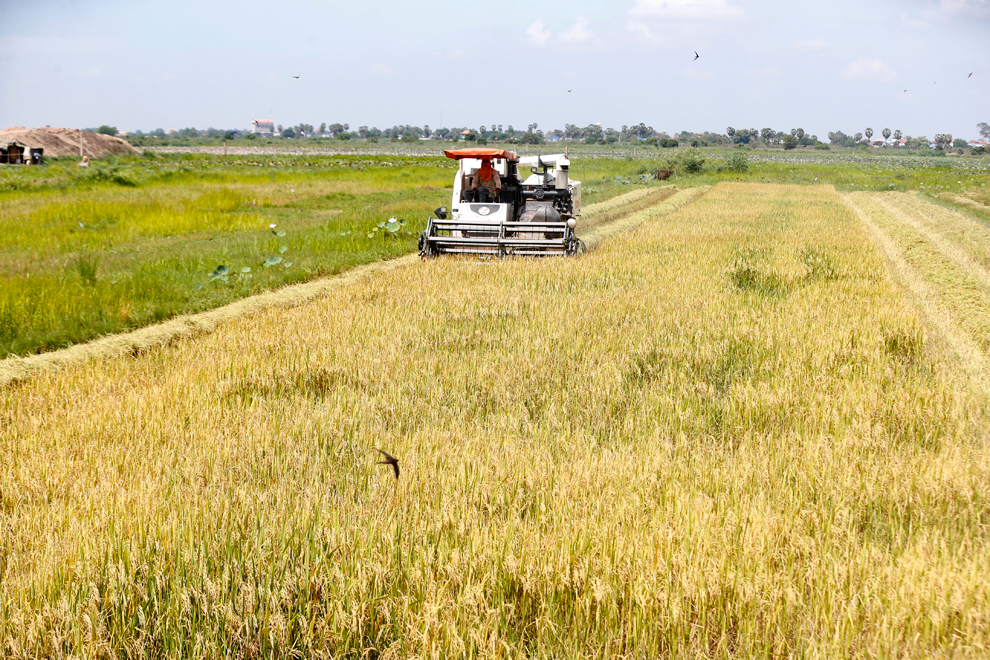
Cambodia informally exported 2,893,951 tonnes of paddy worth more than $723 million in 2020, according to figures revealed by Minister of Agriculture, Forestry and Fisheries Veng Sakhon. Heng Chivoan
Booming demand in the Vietnamese market has taken prices of OM 5451 paddy on a wild ride during and beyond the dry-season rice harvest season this year, according to industry insiders.
OM 5451 is a high-yielding long-grain cultivar of fragrant rice mainly grown in the Mekong Delta, created by a crossbreed combination of Jasmine 85 and OM 2490 varieties for pest and disease resistance.
The cultivar has bulked up yields for the Kingdom’s farmers, with the Khon Rang Reak Reay Cooperative in Kampong Chhnang’s Boribor district logging averages as high as 6.5 tonnes per hectare, according to its head Prum Narin.
In contrast, General Directorate of Agriculture chief Ngin Chhay told The Post late last month that the dry season ended with a total yield of 2.93 million tonnes on a total cultivated area of 646,530ha, or an average of over 4.5 tonnes per hectare.
A list published by the Cambodia Rice Federation on May 17 revealed that OM 5451 is going for 900-950 riel ($0.23-0.24) per kilogramme in Kampong Chhnang province, 920-940 riel in Kampong Thom province, 940-970 riel in Banteay Meanchey province and 900-930 riel in Prey Veng province.
Narin told The Post on May 19 that traders were buying up this year’s dry season paddy at higher prices than last year.
Traders were shelling out up to 1,100 riel per kilogramme in early March, before reducing that to 800 riel, while the harvest was in full swing, he said, adding that the OM 5451 paddy now rakes in 950 riel per kilogramme, up by 14 per cent year-on-year from 830 riel.
Rising demand for the crop was propelled chiefly by the Vietnamese market, he said, noting that local millers were refusing to pay out higher rates.
Lon Sim, president of the Santuk Krao Thkum Thkeung Agricultural Cooperative in Kampong Thom’s Santuk district, said his cooperative now grows a lot of OM 5451 rice due to its strong market.
A growing labour market and favourable weather have provided a major boost to this year’s harvest, he said, adding that traders were buying up the paddy at 900 riel per kilogramme on May 19, marking a slim increase year-on-year.
“This year’s paddy is very expensive and traders are coming to the fields to buy,” he said.
Chan Pich, general manager of rice exporter Signatures of Asia Co Ltd, said his company had ordered 8,000 tonnes of dry season paddy for stockpile to mill and process.
“Both the yield and the price of paddy rice in the dry season this year are better because most farmers are producing fragrant paddy rice that has a strong market demand. But nevertheless, Cambodia’s milled rice exports to international markets has seen a slight decrease in recent months,” he said.
Last year, the Kingdom informally exported 2,893,951 tonnes of paddy worth more than $723 million, according to figures revealed by Minister of Agriculture, Forestry and Fisheries Veng Sakhon.
In Cambodia, two crops of rice are typically grown per year. The monsoon-season (or long-cycle) crop is generally planted in late May through to July and harvested in December, whereas the dry-season (or short-cycle) crop is planted in November and collected in January-February of the following year, according to the UN Food and Agriculture Organisation.












